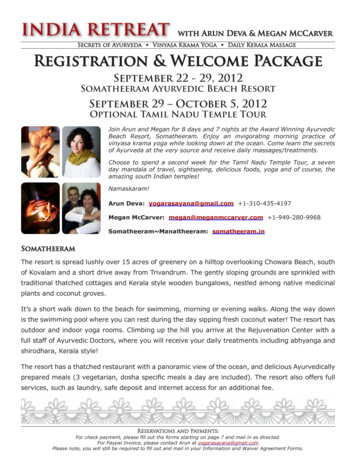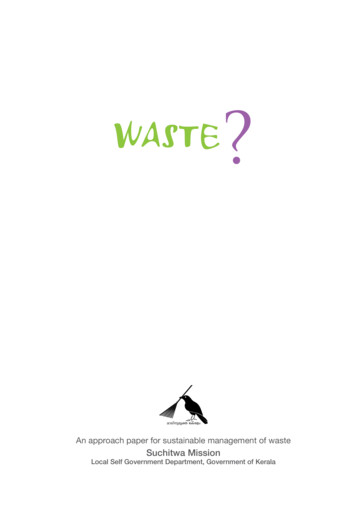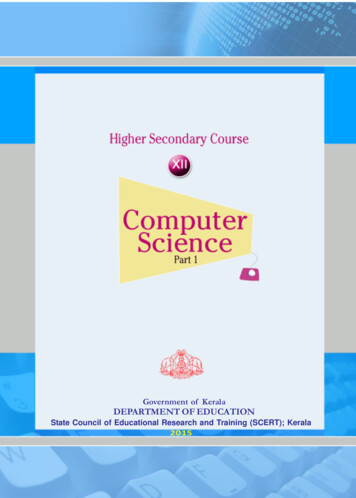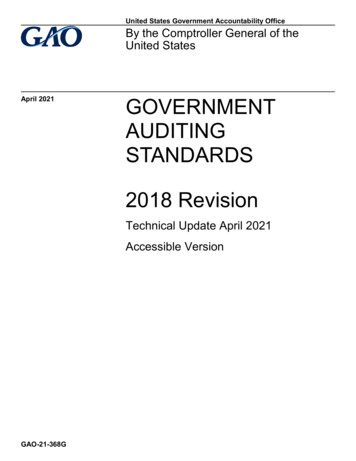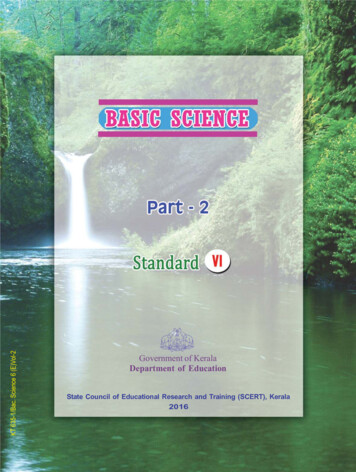
Transcription
KT 635-1/Bac. Science 6 (E)Vol-2Government of KeralaDepartment of EducationState Council of Educational Research and Training (SCERT), Kerala2016
The National AnthemJana-gana-mana adhinayaka, jaya angaUchchala-Jaladhi-tarangaTava subha name jage,Tava subha asisa mage,Gahe tava jaya gatha.Jana-gana-mangala-dayaka jaya heBharatha-bhagya-vidhata.Jaya he, jaya he, jaya he,Jaya jaya jaya, jaya he!PledgeIndia is my country. All Indians are mybrothers and sisters.I love my country, and I am proud of its richand varied heritage. I shall always strive to beworthy of it.I shall give respect to my parents, teachers andall elders and treat everyone with courtesy.I pledge my devotion to my country and mypeople. In their well-being and prosperity alonelies my happiness.State Council of Educational Research and Training (SCERT)Poojappura, Thiruvananthapuram 695012, KeralaWebsite : www.scertkerala.gov.ine-mail : scertkerala@gmail.comPhone : 0471 - 2341883, Fax : 0471 - 2341869Typesetting and Layout : SCERTPrinted at : KBPS, Kakkanad, Kochi-30 Department of Education, Government of Kerala
Dear children,How many are the sights we witness, the sounds we hear, andthe experiences we pass through everyday!In fact, the study of science begins exactly when we think aboutthe ‘what’ and ‘how’ of things we have seen, heard andexperienced. It is not confined to the four walls of the classroom.You have earlier observed a number of things like plants,animals, water, soil and air. Your observation now has to be ata more micro level.This textbook provides you with ample scope for such activitiesand tools. It provides you with suggestions to boost your scienceclub activities and hints at ICT possibilities. There are alsosuggestions at the end of each lesson for activities that you cando on your own. Try to do all of them with the help of yourteachers. We can definitely create a society with scientifictemper.With love and best wishes,Dr.J.PRASADDirectorSCERT, Kerala
Textbook Development TeamSanu V KSr. Lecturer DIET, TirurMalappuramManoj KottakkalGMUPS, KottakkalIllyas PerimbalamGVHSS, NellikkuthuAdatt VasudevanAUPS, NellisseriSeraphin PinheiroUPSA (Rtd.), GUPS, VellangallurSunandan T PAkkara UPS, KavasseriVasudevan PVPAUPS, VilayilAjith Kumar MURC South, ThiruvananthapuramArun S NairCHS, AdaykakunduMohammed Abdul Nazar KIT@ School, KozhikkodePrathapanAUPS, Ezhuvanthala North, PalakkadExpertsDr Alaudeen M, Principal (Rtd.), Govt. College, Elerithattu, KasaragodDr S Mohanan, Reader & Head (Rtd.), Department of Physics, University College, ThiruvananthapuramSebastian Lukose, Professor (Rtd.), University College, ThiruvananthapuramProf. Sivasankara Pillai, Reader & Head (Rtd.), Department of Physics, Women's College,ThiruvananthapuramPaul P I, Associate Professor, Department of Zoology, Mar Ivanios College, ThiruvananthapuramDr. N.Ratheesh, Asst. Professor, SN College, KollamEnglish VersionDr. Saji Mathew, Asst. Professor, School of Letters, M.G.UniversityDr. Vishnu.V.S, Asst. Professor in Chemistry, College of Engineering, ThiruvananthapuramAnil.M.R, HSST, Govt. Girls HSS, KaramanaFamila E R, HSST, GHSS, KarunagappallyK Suresh Kumar, HSA, AMHSS, ThirumalaArtistsMusthajib E C, MMETHS, MelmuriNoushad Vellalasseri, Ganapath AUPS, KeezhisseriMuhammed Shameem, VAUPS, KavanoorLohithakshan K, Assisi School for the Deaf, MalapparambuViswanathan P, DDE office, TirurAcademic Co-ordinatorDr. Ancey VarugheseResearch Officer, SCERT
6Living in Harmony797Attraction and Repulsion888Moon and Stars999Mix and Separate11510 For Shape and Strength124
Certain icons are used in thistextbook for convenienceFor further reading(Evaluation not required)ICT possibilities for making concepts clearAvailable in [IT@School, Edubuntu, ApplicationsResources]Significant learning outcomesLet us assessExtended activities School
I who lived happily in thepond is now leading asorrowful life in this glasscage. What a fate!Didn’t you notice the sorrow of the fish?What are the factors in ponds which enable the fish to live? Aquatic plants Are there biotic and abiotic factors in your findings? List them.
Basic Science - VIBiotic factorsAbiotic factorsWhich of these factors are missing for the fish in the aquarium?In unisonNotice the picture. How many arethe organisms living here together!Are there only Living beings?Find out and write them down.Do all organisms depend on thesame biotic and abiotic factors? Which are the biotic andabiotic factors that the crane depends on for its existence?List the biotic and abiotic factors the organisms in your surroundings dependon for their existence.OrganismRelying factorsBioticAbiotic fox worm Every living being depends upon many biotic and abiotic factors for theirexistence.EcosystemThe natural surroundings in which an organism lives is called its habitat. Thebiotic and abiotic factors in the surroundings and their mutual relationshiptogether form the ecosystem.80
Basic Science - VIWhich are the ecosystems in your locality? List them. Sacred groves (Kavu)From the observation note of AmmuVisit any one of these ecosystems.Don’t forget to make use of theBiodiversity Register in yourpanchayat. What all planning must bedone?-Fix the venue and timeSeek help fromexperts- How can we record ourobservation?-Tables-IllustrationsAs it was noon the bottom of the pond couldbe seen clearly. We watched with interestvarious kinds of fishes swimming in water.Some fishes were feeding on tiny plants inthe water. Suddenly a grasshopper fell intothe water. Tup a varal fish sprang up fromthe bottom of the pond and swallowed it.Soon it returned and hid under a stone. Froma hole on one side of the pond came out a watersnake and it caught a frog. Many of us werescared to see this! It was interesting to watch aschool of fish swimming along together. Whena big fish came to catch them, they disappearedbehind the algae in the corner of the pond. Howmany such factors are there in the pond! Water,sand, stone, air, algae, water plants, fish, frogand water snake are some of them. When theteacher took us to see the pond, we neverthought that the pond had such a variety ofthings to be seen and understood.-81
Basic Science - VI -What should be done after the visit?Analysis and modification of the observation notePreparation and presentation of the reportFor foodHave you seen water snake capturing a frog?Water snake feeds on frogs. What are the thingsthat the frog feeds on? GrasshopperFrom where does the grasshopper obtain its food?Let us illustrate these on the basis of how each one becomes food for another.Aren’t there organisms that feed on water snakes? Add them in the illustration.Complete the food relationships using the organisms in the pictures givenbelow.82
Basic Science - VIGrassDeerLionGrasshopperSnakeFowlWormThese types of food relations are called food chains. Find out more such foodchains and write them down in the science diary. Write down the initial levels in the food chains you have found out.Which organisms occupy the top level in the food chains?Green plants always occupy the first level of the food chain. The top level isoccupied by the carnivores. Intermediate ones may be herbivores or omnivores.How many food relations?Notice this WormFrogGrasshopperSnakeEagleCalotes83
Basic Science - VI Is it only the frog that eats the grasshopper?Which all organisms are eaten by the lion?How many food chains can you find out from this?Write them down in the science diary.Many food chains join together to form the food web. In nature, we can see many foodwebs.Prepare a food web by including organisms you are familiar with.Producers and consumersWe have found that the first level of any food chain is always occupied bythe green plants. What might be the reason for this? Discuss this matter inconnection with the idea of photosynthesis.Green plants prepare their own food. So they are known as producers. Organismsthat depend on other organisms for their food are called consumers. Do lion and tiger depend on plants for food?Where do the animals preyed upon by the lion and tiger get their food from?It is now clear that all organisms directly or indirectly depend on green plantsfor food.Mixing with the soilGreen plants need certain nutrients to prepare food and grow. Plantscontinuously absorb these nutrients from the soil. Still, how do these nutrientsremain in the soil always?Observe the fallen leaves under a tree and write down the findings.Leaf observed84 A leaf which had fallenone or two days ago. A leaf which fellseveral days ago.Changes in the leaf
Basic Science - VIWhat happens to the body parts of plants and animals when they die?DecomposersMicroorganisms like bacteria and fungibreak organic remains and add them tothe soil. So they are called decomposers.FungusThe nutrients formed as a result ofdecomposition further become availablefor the growth of plants.BacteriaAnalyse the illustration given below and explain the relations amongproducers, consumers and decomposers.consumersfoodsainremaddedead nutrientsWhen we intervene in natureIt must be clear to you by now that producers, consumers, decomposers andabiotic factors are all part of the ecosystem. What change will occur in theecosystem when any of these factors is altered?Many activities of human beings cause destruction to the ecosystem. Listthem.85
Basic Science - VIObserve the situations given below.Discuss the problems caused by the levelling of land and filling of paddyfields, based on the indicators given below. Write them down in the sciencediary. Which are the ecosystems destroyed by these activities?What all organisms lose their habitats?Which organisms would face scarcity of food?How do these activities affect the availability of abiotic factors necessaryfor the growth of plants?So, we have found out that all organisms including producers, consumersand decomposers are interdependent. The importance of keeping andpreserving each of them may be presented in a seminar. There are manyinstances of the adverse effects of human interventions in the ecosystem.Suggest remedial measures for these interventions in your seminar.See 'Jaiva Vyvidhyam Innale Innu Nale' in School Resources in IT@School, Edubuntu.The learner can 86explain ecosystems identifying their peculiarities.explain food chains, food webs and illustrate them.
Basic Science - VI explain the various factors of an ecosystem like producers, consumersand decomposers and identify their inter-relation. engage in the conservation of ecosystems by identifying the adverseeffects caused by human intervention.1.Find out the maximum number of food chains by including theorganisms given below.Tortoise, fish, aquatic plants, kingfisher, water snake, eagle, frog, crab,mushi (Cat fish).2.Ruby tabulated the various factors in a pond as follows.ProducersAlgaeWater LilyLotusSmall fishConsumersWater snakeCrabFrogVaral (Snake head fish)DecomposersBacteriaSmall fishFungiAbioticFactorsWaterAirSandStones Are there only suitable ones in each group? Which are the unsuitableones? Explain the interdependence of the various factors in this ecosystem.3.Explain how different organisms will be affected if a large mango tree iscut down.1.Collect newspaper reports on human interventions that brought aboutdestruction of various ecosystems. Prepare a magazine.2.Write a letter to the local self government officer requesting him/her totake necessary actions to protect the ecosystem under threat in yourlocality.87
Whenever there is a strongwind, the front door of Neenu'shouse usually bangs againstthe wall. Neenu and herbrother managed to get someobjects and they fixed them onthe portion connecting the walland the door. Now if the dooris opened, it remains close tothe wall itself. The door doesnot bang against the wallwhen the wind blows. Havingnoticed this their motherasked,“What trick have you bothdone there?”Yes, what might have theydone?Can you suggest any methodusing the objects mentionedbelow?
Basic Science - VISet 1 – wooden block, gumSet 2 – magnet, iron pieceSet 3 – two magnetsSet 4 – bricksMagnets that attractHave you heard of magnets? What do you knowabout them?Magnets attract certain objects. Which are they?Let’s try this activity.Bring pins, a blade, safety pins and an iron nail close to a magnet. See whathappens.Those that attract and those that do notFrom the given list, find out those which are attracted by a magnet.Materials required:Hinges, different coins, screwdriver, compass, stainless steel utensil,aluminium wire, copper wire, pen, rubber, glass piece, spoon, gem clip, plastic.Tabulate your findings in the science diary.KT 635-2/Bac. Science 6 (E)Vol-2Those attracted by magnetThose not attracted by magnetYou may expand the table by examining other objects in and around yourhome too.There are many objects that are attracted by a magnet. What are they made of?Substances attracted by magnet are magnetic substances and those not attractedare known as non - magnetic substances. Iron, nickel, cobalt and steel are magneticsubstances.89
Basic Science - VIStory behind the discovery of magnetA Greek shepherd named Magnus was grazing his sheepon a hilly area holding a stick in his hand. While climbinga rock, he felt that his stick had got stuck to the rock. Itwas the piece of iron at the tip of the stick that wasattracted by the rock. The rock was nothing but lodestone,capable of attracting iron. The Greeks later started callingsuch rocks as magnetite. These are natural magnets. Lateron magnets were made using iron, steel etc. Such magnetsare artificial magnets.Different types of magnetsAre all magnets of the same size and shape?Do you have a magnet? What is its shape?Let’s familiarise ourselves with different types of magnets. Examine thefigures showing some common magnets in use.Bar magnetU magnetDisc magnetRing magnetArc magnetCylindrical magnetWhich among these have you seen? Examine the magnets in your school lab.Magnets are made using ‘alnico’ which is an alloy of aluminium, nickel, cobalt andiron. Substances like neodymium and samarium are also used for making magnets.Uses of magnetsWhat are the different purposes for whichmagnets are used?Sound is produced by speakers in TV, radio,mike sets (public address systems) etc.Magnets are used in speakers. There aremagnets in mobile phones and head phonestoo. Find out more devices that make use ofmagnets and tabulate them.Observe both the figures.90
Basic Science - VI What may be the reason for keeping big speakers in sound boxes andsmall ones in headphones? Do both the speakers need sounds of the same loudness?Reason behind using a largemagnet in loud speakersReason behind using a smallmagnet in headphones.When a person addresses a crowd, whichspeaker would be ideal?Why do magnets differ in shapes?We have learned the shape of magnets usedin speakers. Take a look at the figure showingthe magnets used in a mini motor. What may be the reason behind thedifference in the shape and size of these magnets?The shape and size of magnets differ according to the device in which theyare placed. Arc shaped magnets or ring tube magnets are used in mini motors.When magnets attractIs the attractive powerthe same on all sides of themagnets?Materials required:Iron dust, magnets ofdifferent shapes, thinplastic paper / polythenepaper, a chart paper of A4size.To collect iron dustWe can collect iron dust from our surroundings. Wrapa magnet using cloth or paper and drag it along thesoil of the courtyard. Don’t you see a black powdersticking on to it? Does it not prove that there aresubstances on the earth that are attracted by magnets?Likewise we can collect iron dust from workshopsspecialising in iron works.It is difficult to separate iron powder that is stuck toa magnet. That is why it is advised to wrap the magnetbefore collecting iron powder.91
Basic Science - VIActivitySprinkle iron dust loosely onthe chart paper. Suspend abar magnet using a threadand bring it near the irondust. Does the iron powderstick evenly to all parts of the magnet? In which part is it sticking more?In which part is it less?The end portions of a magnet where magnetic force is strongly felt are the polesof the magnet.Do all magnets have poles?Repeat the above activity using magnets of differentshapes such as circular magnet, ring magnet and Umagnet.Record your activities and findings in your sciencediary.When a magnet is suspendedDoes a freely suspended magnet remain in oneparticular direction always?Materials required: four bar magnets, thread, scale.Take a bar magnet and suspend it horizontally usinga thread in such a way that it is balanced. Ensurethat there are no magnetic substances nearby. Inwhich direction are the poles when the magnet comesto rest? Suspend the other three magnets like this indifferent places in your classroom.Are all the magnets at rest in the same direction?Which is the direction?92
Basic Science - VIAre there markings of S and N on the bar magnets that you have used?Isn’t the end marked S in the south direction andthe end marked N in the north direction? On themagnets having no markings, mark N on the enddirected to the north and S on the other end.Allow the magnets to rotate. Do all the magnetscome to rest in the same direction?NSFreely suspended magnets always come to rest in the north - south direction.When do we make use of this north - south directive property of magnets? In ships to find the direction.To know the direction inside a forest.Imagine that you are standing in an unknown place.You can’t see the sun due to the rains. Can you findout the directions with the help of a bar magnet? How will you find out theeast side?When poles come nearerYou now know that magnets can attract certain metals. Does a magnet attractanother magnet?Activity: Take two magnets on which N and S aremarked. Place one of them on a surface. Bring the poleof the other magnet to the middle of this magnet. Whatdo you observe? Is it to the middle part of the first magnet thatthe second magnet is attracted? Place the magnets closer to each other. Whichpoles stick to each other?NSSN93
Basic Science - VIExamine the figures given below.Which of them are correct?N(A)NSNNS(B)SSN(C)SNSWhat happens if the poles are brought near to each other as shown in thefigure given below?SNSSNNSSNNSNPerform the experiments and tabulate the observations.Situations of attraction Situations of repulsionWhich poles attract each other when the magnets are brought near?Which poles repel each other when the magnets are brought near?Poles of the same type in magnets are the like poles and those of the oppositepoles are the unlike poles. Like poles of magnets repel each other whereas unlike polesattract each other.Conduct experiments using magnets of different shapes and write down thefindings in your science diary.Let’s make a magnetCan magnetic substances be made into magnets?Materials required: a powerful magnet, a big sewing needle and a blade.94
Basic Science - VIActivity:Place the needle on a surface. Using one pole of the magnet rub the needlefrom one end to the other. Repeat the process by lifting the magnet andbringing it to the original position. Rub the needle 15 – 20 times. Rub using one pole alone.Rub in the same direction only.How will you find out whether this needle hasacquired magnetism or not?Can this magnetised needle be used in determining the poles of magnets of different shapes?Suspend the needle using a thread in such a waythat it is balanced. Bring a bar magnet near theneedle. What do you observe? Bring the otherend of the magnet near the needle. Record yourfindings in your science diary.Can you find out the polarity of the magnetised needle?Similarly magnetise a blade. Then take a vessel filled with water and gentlyplace the blade on water so that it floats.What can you infer if the blade comes to rest in the north - south direction?The range of attractionTo what distance can a magnet attractother substances?Is the attractive power of the magnetsame everywhere? Let’s examine.Materials required: magnet, needle,scale and stand.Activity:Suspend the needle using the thread in such a way that it is balanced.95
Basic Science - VIPlace the scale on the table in such a way that one end of it is below theneedle. Move the magnet on the scale from the other end to the side of theneedle. Stop moving the magnet when the attractive force is felt on the needle.Measure the distance to the needle.Slowly move the magnet towards the needle. Observe the changes in theneedle in each instance.Is there a change in the attractive forceon bringing the magnet near the needle?When is the force of attraction of theneedle at the maximum?Place an A4 size chart paper on the tableas shown in the figure. Sprinkle some iron dust over it loosely. Bring themagnet below the paper. Gently tap the paper. Measure the extent of the magnetic field by observing the movement ofthe iron dust.Record your activities and observations in the science diary.The magnetic strength is stronger at the regions near the poles. As the distancefrom the pole increases the magnetic strength weakens. The region around a magnetwhere the force of the magnet is felt is the magnetic field.Repeat the experiment using different magnets. Is the attractive power the same for all magnets?Is there any difference while using a U magnet? Write down yourinference in the science diary.Let’s collect magnetsThere are magnets in toys, somevanity bags, purse etc. Examinediscarded toys, speakers and minimotors. Don’t you see magnets inthem? Collect magnets from them.Why don’t we make a toy using magnets?96
Basic Science - VILet’s make a toyMaterials required: thermocol, a small ring magnet, string, a small woodenstick and metal screw.Make models of fish using thermocol. Fix metal screw at the mouth of each.Put the fish into water in a wide vessel. Make a fishing rod using small woodenstick, string and a ring magnet. Can you catch fish using the fishing rod?Try to design the following toys using magnets. Doll that clings together.A bird that remains only in one direction.Fish that swim towards rice grains.A palm that is directed to the south only.Exhibit in the science club the toys and devices youhave made.The learner can recognise and explain the features of a magnet. make toys using magnets.1.Of two identical substances, one is an iron piece and the other is a magnet.How do you distinguish between the two?explain the concept of magnetic field.classify substances as magnetic and non magnetic.understand the uses of magnets of different sizes and shapes and giveexamples.97
Basic Science - VI2.Two bar magnets remain attracted. One pole is marked. Mark the otherpoles.3.Which of the following magnets is used in a speaker? 98ABCDTwo pins are stuck to the north pole of a magnet. The picture shows thefree ends of the pins to be divergent. Is it correct? What is the polarity atthe ends? How will the pins remain when placed at the South Pole? Tryto do.
January 8TuesdayThe celestial sights have always fascinated me. How does the sun rise in the east and setin the west on all days? The sun is always there in the sky during the day. What about themoon? On one day in the evening it is like a crescent on the western horizon and onanother day, at night, it is like a full circle on the eastern horizon. The position of stars isalso changing. How do these things happen?
Basic Science - VIThe excerpt given above is from Shaji’s diary entries. Have you ever hadsimilar doubts?What have you learnt about the sun, the earth and the moon so far? The Earth is spherical in shape.The Earth and the moon receivelight from the sun. Day and night Does light fall everywhere on theearth at the same time? What causes days and nights?Photograph of earth from outer spaceLet’s do an activity.Materials required: Model of earth (globe), a steel rod and an arrangementfor lighting a bulbActivityRemove the globe’s stand. Arrange thebulb and the globe as shown in the figure.The north pole of the globe should betowards the north. Light the bulb afterensuring maximum darkness in the classroom. The bulb is used in place of thesun. Imagine that the globe is the earth.Now observe the globe from the side of its north pole. Don’t you see light inthe portion facing the sun and darkness on the other side? Gently turn theglobe to the left. Now don’t you see that the dark portion entering to thelighted area and the lighted area moving into the dark area?When you turn the globe to the left, in which direction is its rotation? Put mark at the appropriate box: 100From east to westFrom west to east
Basic Science - VIWhat do you understand from this activity? Write down your findings in thescience diary.The earth spins from west to east. It is due to theearth’s rotation that day and night continuously appear.See 'Ravum Pakalum' in School Resources in IT@School, Edubuntu.Sunrise and sunsetWe see the sun rising in the east and setting in the west. The very next day thesun rises in the east again.How does the sun setting in the west rise in the east again?Activity Locate our approximate position in the globe. Fix a small red colour bindi at the top end, awhite one in the middle and green at thebottom. Imagine that you are on the white bindi. Nowthe bindis at the ends are in your east and west. What is the colour of the bindi on the east?On that area, fix a pin in the east-westdirection using a cellotape.What about colour of the one in the west?Light the bulb and gently turn it to the left.Observe the positions of the white bindi when there is sunrise, noon and sunset.On the basis of your findings complete the following table.TimeThe position of white bindiSunrise.Noon.SunsetWhen the white bindi moves from light to darkness.101
Basic Science - VIDue to the rotation of the earth, those in the region movingfrom darkness to light feel sunrise and for those going fromlight to darkness experience the sunset.Mark positions A, B and C on the globe, as shown inthe figure. Make models of children using thermocoland fix them in these positions. Which is the eastand the west of each child?On the basis of the observations, complete thefollowing table:1In which position will the child see the sunrise?2In which direction does A see the sun?3In which position does the child experience noon?4Where does B see the sun?5In which position does the child see the sunset?6In which direction does C see the sun?What are the inferences you arrive at by analysing the table?Try to turn the globe from the north pole. Don’t you see that people in eachplace experience sunrise and sunset? In fact, the sun which appears in theeast in the morning, the sun above the head at noon and the sun which sets inthe west in the evening remains in the same place. It is the rotation of theearth that causes day and night.The moon’s path in the skyWe see the sun rising in the east and setting in the west every day. But do yousee the moon like this every day ?Where did you see the moon last night?Do you see the moon every day in the same place during sunset?What is the secret behind the moon appearing at different positions eachday?102
Basic Science - VILet’s observe the moonGiven below are the positions of the moon at the time of sunset observed byAppu on three different days.W EWEWEIs there a change in the position of the moon?In which direction does the change of position take place ?.The position of the moon appears to change because of the revolution of the moonaround the earth. Moon completes one revolution around the earth in 27 13 days.The mystery of moon’s crescentDid you notice any other features when you observed the moon?Don’t you see that the shape of the moon also changes along with its changein position each day? Sometimes we see it in the shape of a crescent andsometimes as a full circle. Why is it so?Try out the following activity.Materials required: Five yellow plastic smiley balls, five glass cups, five stoolsand an emergency lamp.ActivityDraw a semicircle on thefloor of the class roomin east-west direction.Arrange the stools, thecups and the balls in fiveequidistant positions asshown in the figure. The2341W View of the child positioned at the centre of the circle5E103
Basic Science - VIsmiling face of all the balls should face the centre of the circle. Light theemergency lamp and place it in the west side in such a way that the light fallson the balls. As far as possible, prevent the light from the outside entering theclassroom by closing doors and windows. From the centre of the circle, observeall the five balls. The smiling face of the ball placed in which position is completely exposedto light? The smiling face of the ball placed in which position is not exposed toany light at all?The smiling face of the ball placed in which position is partially lit bythe light?3Imagine that the semicircle is the half of the path along which themoon revolves, and the balls asthe moon you see on differentdays.Observe the figure.2145Different positions of the moon WEin its path of revolution aroundthe earth are depicted here. Is it possible to see the moon when it reaches the position marked 1?Why? What change occurs in the appearance of the moon when it comes tothe position marked 2? In which position do you see the full moon? In which position do you see the half moon?Analyse the figure and match the facts given bel
These types of food relations are called food chains. Find out more such food chains and write them down in the science diary. Write down the initial levels in the food chains you have found out. Which organisms occupy the top level in the food chains? Green plants always occupy the first level of the food chain. The top level is

